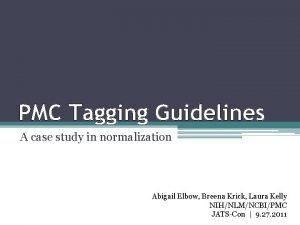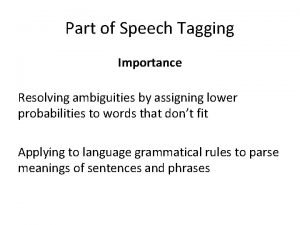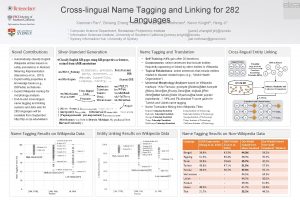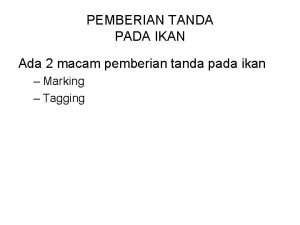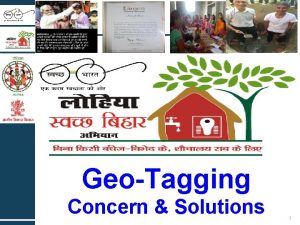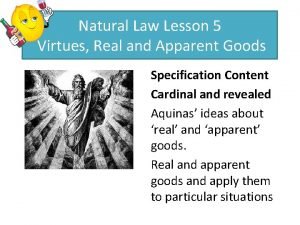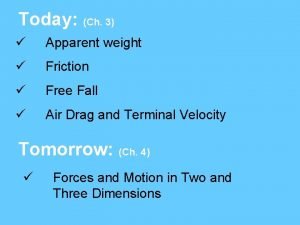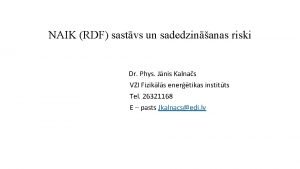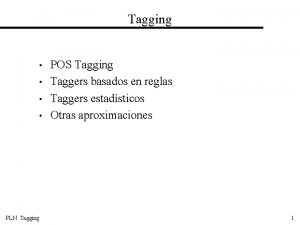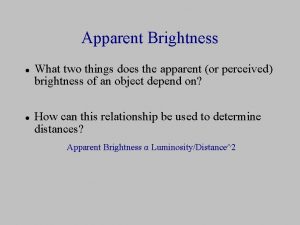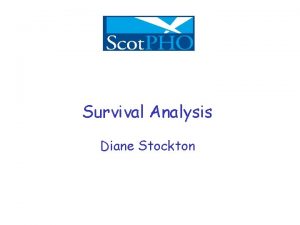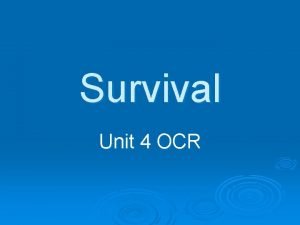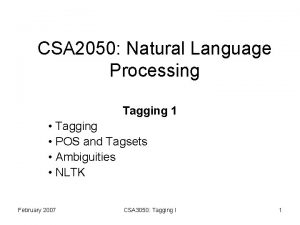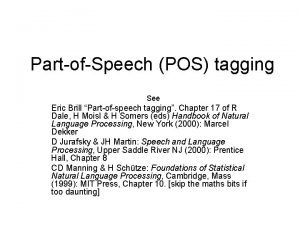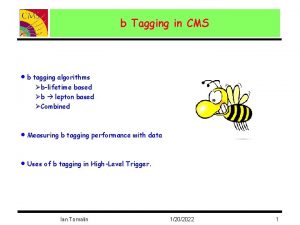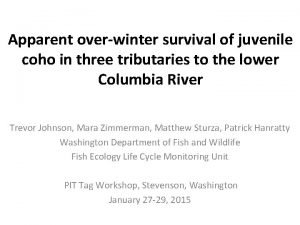EFFECT OF SIZEAT TAGGING ON THE APPARENT SURVIVAL





























- Slides: 29

EFFECT OF SIZE-AT TAGGING ON THE APPARENT SURVIVAL OF CHINOOK SALMON IN ENTIAT RIVER, WASHINGTON PIT Tag Workshop Skamania Lodge, Washington – January 27 th - 29 th, 2015 Presenter: Michael B. Ward Collaborators: Shubha Pandit, Tom Desgroseillier, Keith van den Broek, Michael B. Ward, Chris Jordan, Pamela Nelle , Carl Saunders, Kevin See

Objectives • To determine if there is an effect of fish size at tagging on the apparent overwinter survival rate for Chinook salmon in the Entiat River subbasin. • To determine if changing the minimum size at tagging would be problematic for survival time-series

Background • Permits since 2011: may tag fish 50 -59 mm fork length using 9 mm PIT tags, ≥ 60 mm using 12 mm PIT tags • Proposed restrictions: may not tag fish 50 -59 mm; fish from 60 -69 may only be tagged with 9 mm PIT tags, ≥ 70 mm using 12 mm tags • Proposed restrictions could confound results from on-going studies if detectability or survival rates vary by size class • Proposed restrictions may not be justified through improvements in survival • Change is occurring towards the end of a critical evaluation period (the 2008 -2018 Biological Opinion)

Literature: Size at Tagging on Survival • Coho: (Many papers, esp. Brakensiek and Hankin 2007; Ebersole et al. 2006; Pess et al. 2011; Quinn and Petersen 1996; etc. ). • Steelhead: (Tatara 2009; Connolly and Petersen 2003; Zabel et al. 2005). • Chinook: (Zabel and Achord 2004; Zabel et al. 2005; Knudsen et al 2009) • Zabel and Achord 2004: relative fish length vs. absolute fish length • most studies report relative fish length within populations, is significantly related to survival • absolute fish length is not significantly related to survival • but proposed permit restrictions are in absolute fish length • Zabel et al. 2005: relationship between survival and relative fish length varies across populations and years • In juvenile brown trout and Atlantic salmon impact of PIT tags (11 to 12 mm) on growth and mortality was negligible (Ombredane et al, 1998; Gries and Letcher, 2002), • A few studies (e. g. , Brown et al. 2013) showed only tag burden (ratio of transmitter weight to fish weight) was a concern for mortality.

Methodology • Entiat Intensively Monitored Watershed • 7, 732 Chinook salmon tagged VS 3 • Summer 2010 – Winter 2013 VS 2 VS 1 Mad River

Methodology • Survival estimates calculated using the Barker model for: • Varying size classes • 50 -120 mm, 60 -120 mm, 70 -120 mm, 80 -120 mm • Four discrete size classes i. e. , 50 -59, 60 -69, 70 -79, 80 -120 mm • Repeated these analyses with equal sample sizes • The entire data set with fork length as a covariate

Methodology Absolute Fish Length • Survival estimates calculated using the Barker model for: • Varying size classes • 50 -120 mm, 60 -120 mm, 70 -120 mm, 80 -120 mm • Four discrete size classes i. e. , 50 -59, 60 -69, 70 -79, 80 -120 mm • Repeated these analyses with equal sample sizes • The entire data set with fork length as a covariate Relative Fish Length

Methodology- Model Selection and Goodness of Fit • Barker model • Ten candidate models: fully time varying or time constant • Selection using evidence (weight) ratio derived from the Quasilikelihood Akaike Information Criterion (QAIC) adjusted for overdispersion • Used bootstrap simulations to quantify goodness of fit

Results: Varying Size Classes 50 - 120 mm Survival probability No. tagged = 7, 732 VS 1 VS 2 VS 3 Mad Valley segments of Entiat River and Mad River

Results: Varying Size Classes 60 - 120 mm 70 - 120 mm 80 - 120 mm No. tagged = 7, 732 No. tagged = 6, 780 No. tagged = 5, 471 No. tagged = 3, 348 Survival probability 50 - 120 mm VS 1 VS 2 VS 3 Mad Valley segments of Entiat River and Mad River VS 1 VS 2 VS 3 Mad

Survival probability Results: Varying Size Classes 50 - 120 mm 60 - 120 mm 70 - 120 mm 80 - 120 mm No. tagged = 7, 732 No. tagged = 6, 780 No. tagged = 5, 471 No. tagged = 3, 348 No. Marked/Released = VS 1 VS 2 VS 3 Mad No. tagged = 3, 348 VS 1 VS 2 VS 3 Mad Valley segments of Entiat River and Mad River VS 1 VS 2 VS 3 Mad

Results: Length as a Covariate Aug 2011 -March 2012 0. 4 0. 6 0. 8 Aug 2012 -March 2013 0. 0 Survival probability 1. 0 Aug 2010 -March 2011 60 80 100 120 Fork Length (mm) 60 80 100 120

Results: Varying Size Classes Unequal Sample Size 0. 6 Equal Sample Size=3, 348 F 3, 34= 0. 023, p = 0. 97 F 3, 34 = 0. 18, p = 0. 83 Survival probability 0. 5 0. 4 0. 3 0. 2 0. 1 0. 0 50 - 0 12 60 0 2 -1 70 2 -1 80 2 -1 Size class (mm) 50 20 1 - 0 60 2 -1 70 2 -1 0 80 2 -1 0

Results: Discrete Size Classes Equal Sample Size=3, 348 Unequal Sample Size 1. 0 F 3, 30=2. 48, p=0. 07 F 3, 24=0. 42, p=0. 73 Survival probability 0. 8 0. 6 0. 4 0. 2 0. 0 50 - 59 60 - 69 70 - 79 80 -120 Size class (mm) 50 - 59 60 - 69 70 - 79 80 -120

Results: Year Effect August 2010 - March 2011 August 2011 - March 2012 Unequal Sample Size 0. 5 August 2012 - March 2013 Equal Sample Size class × Year: F 6, 36= 0. 09, p=0. 99 Size class × Year: F 6, 36=0. 19, p=0. 97 0. 4 Varying Size Classes 0. 3 0. 2 Survival probability 0. 1 0. 0 -0. 1 20 1 0 - 5 2. 0 1 0 - 20 6 1 0 - 7 20 0 12 0 8 Size class × Year: F 6, 22=1. 43, p=0. 25 1. 5 20 1 0 - 6 20 1 0 - 7 20 1 0 - 8 Size class × Year: F 6, 16=1. 91, p=0. 14 Discrete Size Classes 1. 0 0. 5 0. 0 -0. 5 -1. 0 50 - 59 60 - 69 70 - 79 80 -120 50 - 59 60 - 69 Size class (mm) 70 - 79 80 -120

Results: Secesh R. Preliminary results from ISEMP work in the Secesh, courtesy QCI.

Summary: Secesh River (preliminary results) • Time of tagging and or timing of emigration plays a larger role in juvenile mortality than size at tagging • Failure to tag fish <60 mm would result in a failure to tag about half of the population prior to emigration • The Secesh is fairly typical of Idaho streams – high gradient and cold – greater than 50% of juveniles leave these systems before they’d be taggable under the proposed size restrictions • Failing to tag fish <60 mm would result in non-representative estimates of growth and survival

Summary • There is a positive relationship between overwinter survival and sizeat-tagging in models using size as a covariate. The effect varies by year. • There is no significant difference in apparent survival estimated for four discrete size groups (50 -59, 60 -69, 70 -79, 80 -120 mm), and no significant year effect. • There is no significant difference in survival for four size groups with varying minimum size limits (50 -120, 60 -120, 70 -120, 80 -120 mm), and no significant year effect. • Model estimates of survival did not converge for sample groups with approx. <200 individuals; however, that effect was only seen when looking at finer spatial and temporal groupings, and not at the population level.

Summary • There is a positive relationship between overwinter survival and sizeat-tagging in models using size as a covariate. The effect varies by Relative Fish Length year. • There is no significant difference in apparent survival estimated for four discrete size groups (50 -59, 60 -69, 70 -79, 80 -120 mm), and no significant year effect. Absolute Fish Length • There is no significant difference in survival for four size groups with varying minimum size limits (50 -120, 60 -120, 70 -120, 80 -120 mm), and no significant year effect. Absolute Fish Length • Model estimates of survival did not converge for sample groups with approx. <200 individuals; however, that effect was only seen when looking at finer spatial and temporal groupings, and not at the population level.

Management Conclusions • We see no size-at-tagging effect on survival in Chinook that would justify a change in NOAA tagging protocols. • Simulated restrictions in sample size as proposed by NOAA did not affect subbasin- or valley segment-scale survival estimates. • Simulated restriction in sample size as proposed by NOAA did affect survival estimates at finer spatial/temporal scales. • We infer that: • Proposed NOAA tagging protocols could impact estimates of other key parameters such as movement or growth • Trend information could be confounded by such proposed changes • Proposed NOAA tagging protocols may have impacts on steelhead parameter estimation (prelim. results, Entiat and John Day).


Size Distribution of Marked Fish

Methodology – Barker Model • The Barker model has been found to be robust in our systems (Conner et al. , 2015) • The model incorporates resight data which provides a less biased estimate of survival compared with other models • Encounter history matrix was built using four years data (summer and winter from 2010 to 2013) • Individuals were marked and released (1), resighted or observed (2), not captured (0), or removed (-1)

Research Questions 1. Does the survival probability increases as fish length at tagging increases? Number of Fish Survival Probability 2. Does the estimated survival probability differ if certain fish length group is excluded? >=60, >70, >80 etc 3. What is the survival probability for the discrete classes of fork length at tagging? Fork Length at tagging 60 80 100 120

Research Questions 4. Since the number of samples sizes are varied among the classes, we further asked the questions of whether the survival probability would differ: Ø With equal samples sizes among the classes. Ø With unequal sample size.

Background • ISEMP often tags fish 50 -59 mm; with rare exceptions, use 12 mm tags for fish in the 60 -70 range • 9 mm PIT tags probabilities at Instream Detection Systems • The read ranges are typically <50% relative to a 12 mm tag • Therefore we will need to tag more fish to obtain reliable estimates

No. of Fish Size Distribution of Tagged Fish Fork Length (mm)

Results: Discrete Size Classes 50 - 120 mm Survival probability No. tagged =7, 732 No. tagged =942 VS 1 VS 2 VS 3 Mad Valley segments of Entiat River and Mad River

Results: Discrete Size Classes 50 - 120 mm 60 - 69 mm 70 - 79 mm 80 – 120 mm No. tagged =7, 732 No. tagged =942 No. tagged =1, 359 No. tagged =2, 073 No. tagged =3, 348 No. tagged =942 Survival probability 50 - 59 mm VS 1 VS 2 VS 3 Mad Valley segments of Entiat River and Mad River VS 1 VS 2 VS 3 Mad
 State of survival survival of the fittest tweak
State of survival survival of the fittest tweak State of survival survival of the fittest stages
State of survival survival of the fittest stages Internal forwarding and register tagging
Internal forwarding and register tagging Stylechecker
Stylechecker Tagging
Tagging Mrrdata.com
Mrrdata.com Raven tools url builder
Raven tools url builder Pos tagging
Pos tagging Xiaoman pan
Xiaoman pan Unsupervised pos tagging
Unsupervised pos tagging Information centric security
Information centric security Apa tujuan pemberian tanda
Apa tujuan pemberian tanda Geo-tagging in panchayat
Geo-tagging in panchayat Untagged vs tagged vlan
Untagged vs tagged vlan Bhuva hfa
Bhuva hfa Donas franchise
Donas franchise Objektif pemulihan khas
Objektif pemulihan khas Fundamental vs realized niche
Fundamental vs realized niche Apparent weight formula
Apparent weight formula Ac systems lesson 5
Ac systems lesson 5 Absolute brightness def
Absolute brightness def Apparent magnitude
Apparent magnitude Hepatic clearance
Hepatic clearance Apparent bulk density
Apparent bulk density A man of weight 75 kg is standing
A man of weight 75 kg is standing In a triangle connected source feeding
In a triangle connected source feeding Apparent goods examples
Apparent goods examples Apparent weight
Apparent weight Apparent brightness
Apparent brightness Apparent density
Apparent density



